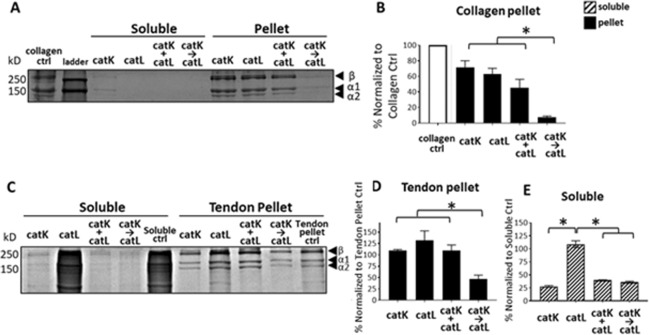Figure 1.
Matrix substrate co-incubated with sequential catK then catL yielded greater collagen cleavage than concurrently incubated catK and catL. Collagen gels and tendon ECM were incubated with catK alone, catL alone, and catK co-incubated with catL concurrently (+), or sequentially (→) for 8 hrs. After centrifugation, SDS-PAGE was conducted on the soluble and pellet fractions of each experiment. SDS-PAGE showed the alpha chains from the collagen pellet with little to no collagen remaining in the soluble fraction after 8 hr cathepsin incubations. (A) Collagen control sample was just the collagen gel incubated for same length of time, but in the absence of any added cathepsins. This is the pelleted gel as there was little to no collagen in soluble fraction in the absence of enzyme. Sequentially incubated catK and catL (→) cleaved significantly more collagen than catK concurrently co-incubated with catL (+), or either enzyme alone. (B) SDS-PAGE run on the tendon ECM showed fragments released into the soluble fraction and the remaining alpha chains in the pellet after incubation. (C) Tendon pellet control sample was just tendon ECM, incubated in buffer for same length of time, but in the absence of any added cathepsins. Soluble fraction collected from this control was prepared as other soluble fractions and labeled the soluble ctrl. In the tendon ECM pellet fraction, similarly to the collagen pellet, SDSPAGE showed significantly greater cleavage with sequential co-incubation (→) than catK alone, catL alone, or concurrent co-incubation of catK and catL (+). (D) In the soluble fraction, catL alone was not able to degrade the ECM fragments, leaving significantly more fragments than catK alone, concurrent (+) and sequential (→) catK and catL. (E) n = 3, *indicates statistical significance, p < 0.05 as determined by a one-way ANOVA. Error bars represent SEM.

